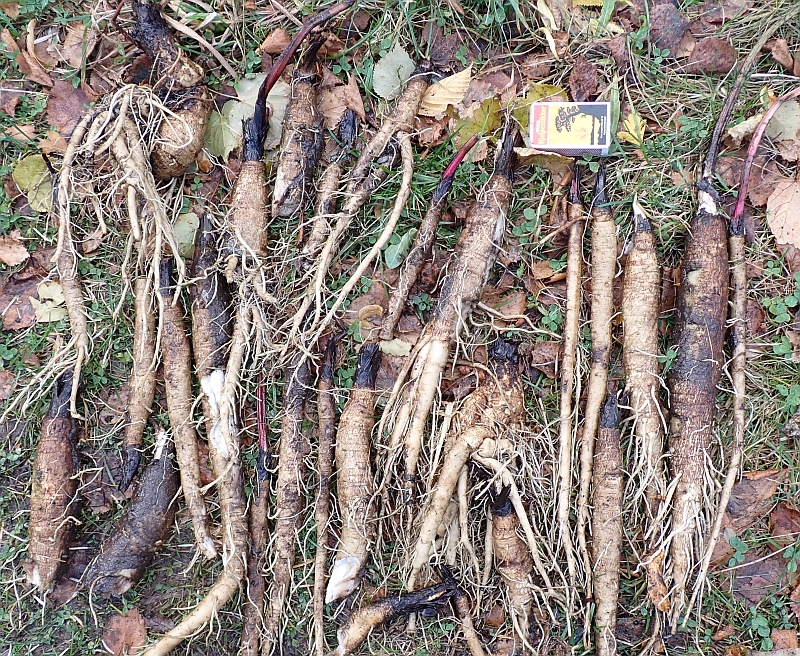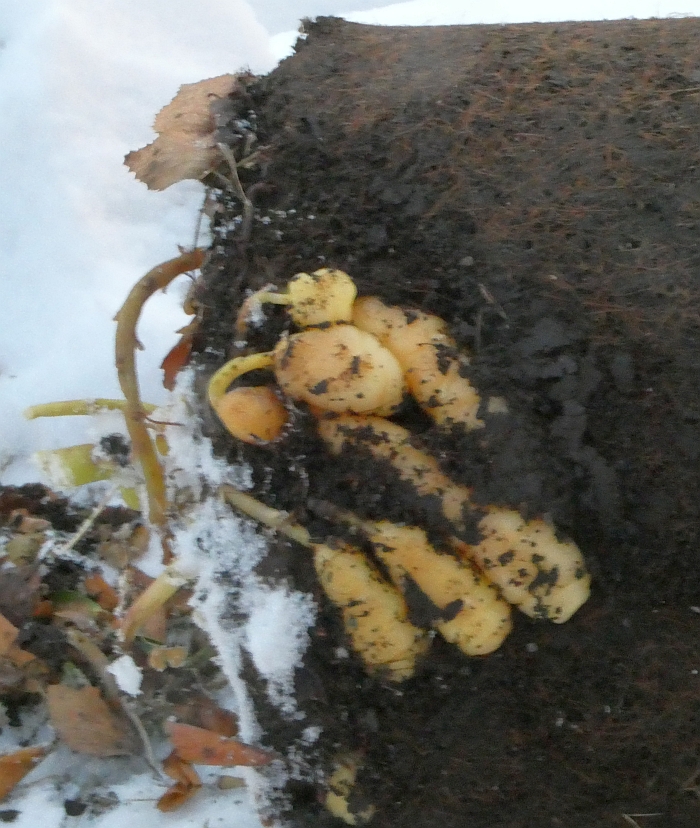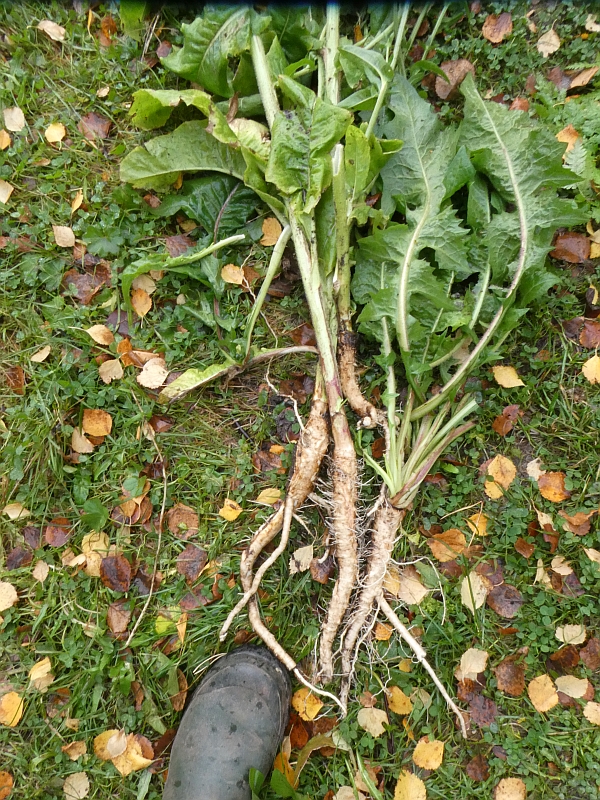I used some burdock / borre root (Arctium lappa) in an oriental stir-fry the other day. They’ve been stored in autumn leaves in the cold cellar since autumn and now with the temperature increasing, the roots had developed many white root hairs. Their function is to dramatically increase the root surface area and hence interface with the soil, and hence enhancing the absorption of water and minerals.


Category Archives: Root crops
Rampions for the hungry gap
The rampions (vadderot in Norwegian, Phyteuma in Latin) has been naturalizing in my garden but so far keeping to the cultivated beds. I needed to dig up a few this week as it was outcompeting some other plants I wanted to keep. I cooked the roots and they were delicious and almost fibre-free and used in a salad. Along with other plants in the Campanulaceae this is a very useful root crop for the root hungry gap! And just look at the bumble bees swarming over the flower tops, always the most popular plant for the white-tailed bumblebees (jordhumler), one of the most useful plants to grow, both tasty (I use also spring leaves and flower buds), nice to look at and a pollinator friendly, ticking all 3 boxes required to categorise it as an edi-ento-mental!
Thr film shows bumble bees on a white-flowered patch of Phyteuma spicatum (spiked rampion).
See also these posts about Phyteuma:
https://www.edimentals.com/blog/?p=21018 (an article I wrote on the ethnobotany of Phyteuma “The perennial rampions: Shade tolerant edientomentals”)
https://www.edimentals.com/blog/?p=18624 (Rampions for dinner)
https://www.edimentals.com/blog/?p=11910 (Rapunsel)




Xmas diversity from the rhizosphere
Presenting this year’s 30 rhizosphantastic Xmas vegetables, all roasted in the oven, served as every year in the last 40 with nut roast, bedecked with the following seeds / bulbils: alpine bistort / harerug (Polygonum viviparum), Himalayan balsam / kjempefringfrø (Impatiens glandulifera), evening primrose / nattlys (Oenothera biennis) and opium poppy (Papaver somniferum). The tubers are listed below the pictures.



The 30 tubers, roots and rhizomes in the picture are:
Solanum tuberosum (potato / potet: 11 varieties)
Daucus carota (carrot / gulrot)
Oxalis tuberosa (oca: 2 varieties)
Arctium lappa (burdock)
Scorzonera hispanica (Scorzonera / scorsonnerot eller svartrot)
Tigridia pavonia (cacomitl)
Pastinaca sativa (parsnip / pastinakk)
Beta vulgaris (beetroot / rødbete)
Tropaeolum tuberosum (mashua)
Anredera cordifolia (Madeira vine)
Helianthus tuberosus (Jerusalem artichoke / jordskokk : 3 varieties)
Brassica rapa (turnip / nepe)
Brassica napus (swede / kålrot)
Dahlia (Dahlia / georginer)
Polymnia sonchifolia (yacon)
Sagittaria latifolia (wapato)
Allium cepa (onion)
Oca harvest 2022
Xmas isn’t Xmas without Oca and a hoard of other tubers, served with the traditional nut roast. Pre-xmas preparations includes the annual oca harvest. Oca (Oxalis tuberosa) is a short day root crop hailing from the central and southern Andes. When harvested at the first frosts, yields are poor, the plants needing a long mild autumn to fatten up the tubers for the festive season. I therefore grow my oca in large buckets which we bring into the extension to the house at the first hard frosts which was late October this year. We don’t heat the extension which is normally a fairly constant 5-10C in winter and hence a good place to store vegetables and other plants like my bay tree (Laurus nobilis). There’s no sunlight and I don’t use artificial light so there’s no diurnal variation in temperature either. The oca plants don’t grow vegetatively, but miraculously the tubers do grow over the few weeks to harvest:
“Over the top” Flowery Whopper Carrot Salad
I was going to post an album of pictures showing off all the late flowers in the garden this record-breaking mild autumn still without any frost, but as they’re all edible I made a salad instead!
There were 33 different edible flowers (see the list below the pictures) plus 30-40 greens and a whopper carrot which I decided to keep whole as a feature! It was cut up when the salad was tossed afterwards. It has a story too as it is one of the Danish accessions rematriated from Seed Savers Exchange (SSE) in the US last winter. I took a few seed before sending the rest on to Danish Seed Savers (Dansk Frøsamlerne). It’s called Kämpe which means Giant in Swedish/Danish (I call it Whopper as it’s probably the biggest/thickest carrot I¨’ve grown here). It’s not a very old variety and SSE informed that it was a cultivated variety originally from the Swedish seed company Weibulls. Anyone know more about it?






Salad flowers, all harvested from the garden
Salvia (blackcurrant sage / solbærsalvie)
Fuchsia magellanica
Hemerocallis “Stella de Oro”
Taraxacum spp. (dandelion / løvetann)
Rubus fruticosus (blackberry / bjørnebær)
Papaver somniferum (opium poppy / opium valmue)
Viola altaicum
Campanula persicifolia (peach-leaf bellflower / fagerklokke)
Sonchus oleraceus (common sow-thistle / haredylle)
Glebionis coronaria (chopsuey greens / kronkrage) (3 varieties)
Daucus carota (carrot / gulrot) (unopened flower umbel)
Geranium sanguineum (bloody cranesbill / blodstorkenebb)
Brassica oleracea (kale / grønnkål)
Oenothera biennis (evening primrose / nattlys)
Begonia
Malva moschata (musk mallow / moskuskattost) (white and pink flowered)
Malva alcea (hollyhock mallow / rosekattost)
Monarda fistulosa (wild bergamot / rørhestemynte)
Monarda “Elsie Lavender”
Calendula officinalis (pot marigold / ringblomst (2 varieties)
Campanula trachelium (nettle-leaved bellflower / nesleklokke)
Calamintha nepeta (lesser calamint / liten kalamint)
Tropaeolum majus (nasturtium / vanlig blomkarse) (2 varieties)
Pisum sativum (garden pea / ert)
Origanum spp. (wild marjoram / bergmynte) (2 varieties)
Campanula lactiflora
Alcea rosea (hollyhock / stokkrose)
Tragopogon pratensis (Jack-go-to-bed-at-noon / geitskjegg)
Burdock harvest
I have a large bucket on the balcony where i grow greater burdock (Arctium lappa) for the birds, Both goldfinches (stillits) and greenfinches (grønnfink) eat burdock seed in winter and by growing the plants on the balcony I have close views of both species from where I’m typing this! Last year, the plants flowered and set seeds, they germinated en masse this spring, I thinned them and this was the harvest today. The largest roots and the smallest ones will be replanted in the spring. The others will be eaten in oriental stir-fries this winter.
See also other burdock posts: https://www.edimentals.com/blog/?s=arctium
Sweet cicely / chicory root scrambled egg
I had been asked if I had photos of the roots of chicory (sikkori) and sweet cicely (Spansk kjørvel) for a talk about wild edible roots. I therefore dug some from the garden.
Inspired by traditional Mediterranean ways of preparing wild and cultivated vegetables, I boiled the roots and they were then stir-fried with onions and winter chantarelle mushrooms before being added to scrambled egg (see the pictures for more).
All the roots on the perennial chicory were far too fibrous to eat, but the sweet cicely roots were good (at least the younger ones!)
More or less any vegetable can be prepared this way!
Simple is best!
20 seasons with Sarpo potatoes
(Norwegian under)
This year was the 20th season of growing Sarpo potatoes here in Malvik/Trondheim and yields are as good as ever with 100% blight resistance! These were harvested from the community garden at Væres Venner in Trondheim this week. My favourite variety is Sarpo Tominia which seems to be a little earlier and therefore better for areas with early frost (they remain vigorous right through to the time when the first hard frosts kill the foliage). I’ve also grown Sarpo Mira since 2009 and have also tried Sarpo Axona and “Sarpo Surprise” (from true seed).
Norwegian: I år var det den 20. sesongen med dyrking av Sarpo-poteter her i Malvik/Trondheim og avlingene er like gode som alltid med 100 % tørråte-resistens! Disse ble høstet fra felleshagen på Væres Venner i Trondheim denne uken. Min favorittsort er Sarpo Tominia som ser ut til å være litt tidligere og derfor bedre for områder med tidlig frost (den vokser helt frem til de hardfrostene). Jeg har også dyrket Sarpo Mira siden 2009 og har også prøvd Sarpo Axona og “Sarpo Surprise” fra ekte frø.
Bitter baccalao: roots and greens
No, I’m not vegan and have never been, I’ve been lactovegetarian with the occasional wild fish over 40 years. We always have some Norwegian dried cod (baccalao) at the ready in our cool larder. The usual way to make the dish baccalao here is to hydrate the fish for a couple of days and then layer potatoes, bulb onions, fish, tomatoes, garlic with olive oil, pepper and chili in large saucepan. I’ve always added seasonal greens too and often use green onions of various types instead of bulb onion.
Last night, we used the last of the potatoes from the cellar and as there weren’t many also used root chicory (di Sancino: an edible rooted variety that produces well here) and the last yacon roots, all still in perfect condition kept in the cellar in dryish leaves all winter! We also used a good bunch of nettles, tops of giant bellflower (Campanula latifolia) and sweet cicely (Myrrhis odorata) tops including the flowers. For the onions, sand leek (Allium scorodoprasum) and victory onion (Allium victorialis) were in perfect condition (beginning to flower).
The verdict on our first bitter baccalao? Delicious, but probably not for everyone!
Xmas day Rhizofantastigora dinner 2021
Xmas dinner in Malvik has been nut roast and roasted roots every year since 1984! This year there were 27 different roots: parsnip, 15 different varieties of potato, bulb onions, Tigridia (cacomitl), wapato (Sagittaria), carrot, beetroot, oca (red and yellow), Madeira vine (Anredera cordifolia), yacon (Polymnia), garlic (Allium sativum), Dioscorea polystachya (Chinese yam) and chicory root (at the top).
The nut roast was made from ground walnuts, hazelnuts and almonds with grated carrots, onion and beetroot with garlic, golpar (Heracleum seed spice), egg, salt, pepper and chili, bedecked with buckwheat groats (home grown by a friend in Czechoslovakia), Himalayan balsam seed, caraway, dill and alpine bistort bulbils (Polygonum viviparum).


































